AI and Manufacturing: How Artificial Intelligence is Reshaping Talent Acquisition
In the manufacturing industry, Artificial Intelligence (AI), is reshaping how we design, produce, and deliver goods. However, amidst the anticipation and excitement, a cloud of misconception looms— the belief that AI spells the demise of manufacturing jobs.
While this assumption feels like a natural conclusion, there’s much more to the story. AI is a catalyst for growth, innovation, and enhanced human potential. But how is AI reshaping the manufacturing landscape? What myths do employers need to quell along the way in order to attract talent in the face of candidate fears?
Let’s explore the current state of the manufacturing job market, the role of AI in shaping manufacturing processes, and how the synergy between AI and human workers drives a collaborative future.
The Evolving Landscape of Manufacturing Jobs: Bridging the Skills Gap
As we stand at the crossroads of thrilling technological advancements in manufacturing, one of the most pressing challenges that the industry faces is the growing skills gap. To truly understand the transformative potential of AI in manufacturing, we must first grasp the current state of the manufacturing job market.
- Bridging the Skills Gap: According to insights from Deloitte, the manufacturing sector is on the brink of an unprecedented skills gap. By 2025, a staggering 3.4 million skilled workers will be required to meet the industry’s demands. Yet, despite this demand, a startling 2 million roles are projected to remain unfilled. This gap isn’t merely a statistic; it’s a critical challenge that the industry must confront head-on.
- The Impending Exodus and Knowledge Gap: The dynamics of this challenge are further amplified by the exodus of experienced workers from the industry. By 2025, around 2.7 million manufacturing workers are expected to retire or leave their roles – and with them goes their knowledge base. This mass departure creates a void that must be filled with fresh talent, possessing the technical skills to navigate modern manufacturing and the innovative mindset to steer the industry into the future.
- A Call to Attract and Retain Talent: The present circumstances underline a clear imperative for the manufacturing industry—to attract and retain a skilled workforce that can navigate the complexities of an AI-infused landscape. This not only requires addressing the misperceptions surrounding AI and job loss but also creating an environment that fosters continuous learning, upskilling, and adaptability.
When considering AI’s impact on manufacturing jobs, it’s vital to address the skills gap and the knowledge gap to ensure that the workforce of tomorrow is adequately prepared to meet the industry’s demands.
The Role of AI in Manufacturing: Unveiling Transformational Integration
Integrating AI into manufacturing processes is akin to adding a master conductor to an orchestra. Without a conductor, an orchestra would be chaotic and not in sync. AI’s algorithms analyze vast amounts of data in real-time, making sense of complexities that human operators might find overwhelming. This enables manufacturers to optimize every step of the production line, from predictive maintenance that reduces downtime to supply chain management that ensures materials arrive precisely when needed.
One of the most apparent impacts of AI in manufacturing is the surge in productivity. AI’s ability to process data at unprecedented speeds enhances decision-making, allowing manufacturers to streamline operations and allocate resources efficiently. With insights drawn from AI-powered analytics, bottlenecks can be identified and eliminated, enabling continuous flow and boosting overall production capacity.
That productivity also breeds efficiency, the cornerstone of modern manufacturing. Machines equipped with AI sensors can self-monitor and adjust settings, maintaining optimal conditions and reducing waste. Moreover, AI’s predictive capabilities empower manufacturers to foresee and mitigate potential disruptions, preventing costly downtimes and ensuring seamless operations.
This is where the misconception comes in that AI is going to kill jobs. The industry needs a solid push to illustrate that while AI improves these key areas, it also helps facilitate human innovation. By offloading repetitive tasks to AI-driven systems, human workers can focus on creative problem-solving and strategic decision-making. This symbiotic relationship between human intuition and AI’s analytical prowess leads to breakthroughs that drive the industry forward.
Dispelling the Misperception: AI and Job Loss
Contrary to the belief that AI is a harbinger of job loss lies the opportunity for it to be a catalyst for job enhancement, productivity amplification, and collaborative innovation.
While machines are in integral part of the manufacturing process the human touch remains an indispensable force in the production of goods. Recent data reveals that people still perform 72% of manufacturing jobs. This statistic underscores the industry’s resilience and the coexistence of human and technological capabilities.
As previously noted, the true magic unfolds when AI and human workers collaborate harmoniously. AI excels in data analysis, automating repetitive tasks, and sifting through massive datasets. This paves the way for human workers to channel their creativity, critical thinking, and problem-solving prowess toward tasks that demand intuition, emotional intelligence, and adaptability—qualities AI struggles to replicate.
Thus instead of replacing all jobs, AI is creating a value-added ecosystem and new opportunities. Imagine a manufacturing floor where AI-enhanced machines provide real-time insights, predictive maintenance, and data-driven suggestions. Equipped with these insights, human workers become decision-makers, strategists, and innovators, translating data-driven possibilities into tangible actions. The synergy between AI and human workers has the potential to yield remarkable outcomes.
Overcoming Candidate Fears and Attracting Manufacturing Talent
The fear of AI-driven job displacement is a valid concern, but it’s essential to contextualize this apprehension within a broader narrative of collaboration. So, what can employers do to quell these fears? Emphasizing the collaborative nature of AI-human interaction in manufacturing is crucial. Employers should focus on highlighting the ways AI will enhance the work environment and experience rather than the ways in which it will replace human-driven tasks.
The good news for employers is that the appeal of technology-focused roles holds significant sway for the younger generation. Growing up in a digital era, the younger workforce is inherently tech-savvy and drawn to industries that embrace innovation. Highlighting the role of AI in manufacturing not only showcases the industry’s technological edge but also positions it as an attractive playground for those seeking to shape the future. There is real opportunity to attract younger workers to the industry by showcasing the ways technology enhances work.
SelecSource: Elevating Candidate Experiences and Redefining Manufacturing Workforce Solutions
Manufacturing companies in Georgia looking to attract talent in the AI age need a workforce solutions and staffing provider on the cutting edge of industry trends. In a world driven by AI and technology, efficiency becomes a cornerstone. SelecSource’s manufacturing workforce management solutions minimize administrative burdens, streamlines contingent workforce management, and offers access to a high-quality workforce at a lower cost—each element a testament to the company’s foresight and innovation.
SelecSource isn’t merely adapting to change; its recruiters are shaping the future. By embracing the changes facing the industry, SelecSource creates a roadmap that is both innovative and human-centric, understanding that at the intersection of technology and human ingenuity lies a landscape where candidates thrive, businesses flourish, and the manufacturing sector continues to evolve.
Embracing the Future: Partner With SelecSource To Attract The Right Talent Today
The integration of AI doesn’t equate to job displacement; it equates to skill elevation. AI is unlocking new avenues for efficiency, innovation, and collaboration through data analysis, predictive insights, and streamlined processes.
Amidst this transformation, one constant remains—the pivotal role of attracting and retaining talent. The manufacturing landscape’s evolution requires a workforce that is not only technically skilled but also adept at critical thinking, problem-solving, and collaboration. As the industry shapes new roles that meld AI insights with human intuition, the focus on talent becomes paramount.
Discover how SelecSource’s approach and AI’s potential can shape your company’s journey. Contact us today to embark on a staffing and workforce management path that leads to a collaborative future where innovation, efficiency, and empowerment intertwine. Together, let’s redefine what’s possible in the world of manufacturing.








